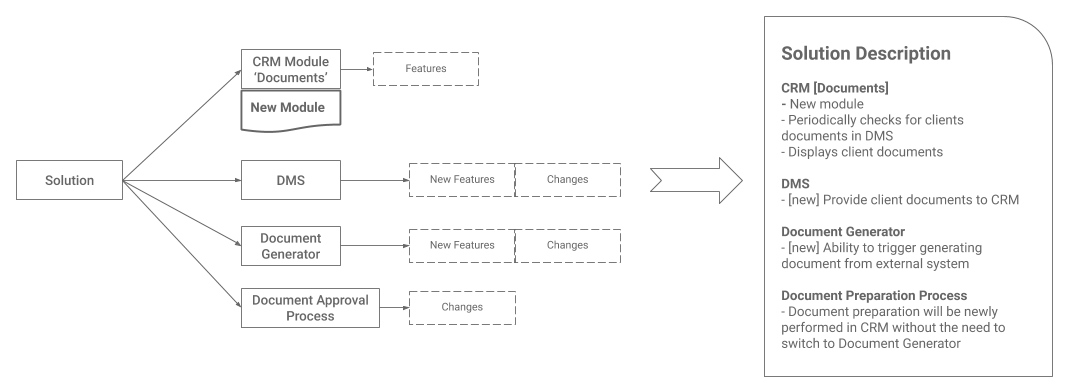Solution Description
After the business goals are clear, the current capabilities are known, and the desired future state of the organization is outlined, the next step is to find a solution to the identified business problem.
Solution is a set of changes the organization must undergo to satisfy a need. This includes major enhancements to existing systems, new application development, business process changes, policy or organizational structure changes, etc. Solution description typically describes which enterprise components or their parts need to be changed and how - whether they will be added, removed, or modified. The goal is not to provide a detailed solution specification, but rather to outline just an overall picture of the solution, and it may slightly differ depending on the size of the change. For bigger changes, the solution description is more high-level and describes just the scope of the solution that defines its boundaries and major organizational components changes. On the other hand, if the solution is formed by a single system or a single system change, the description is usually more detailed. For example, it could include what the software shall do and how it fits into the current organization architecture, so a set of features, integrations, or main data flows could be used.

Apart from the description of the individual components, the solution overview must also include the information why this solution was preferred from others and how it realizes the business goals.
Selecting Solution
In most cases, there is not just one possible solution, so all alternative approaches need to be assessed. Evaluating solution options and selecting the best one could be a lengthy process, which involves considering the feasibility of each solution and assessing impacts the solution might have on the organization. Very often, the costs of the solution are the main deciding factor, so the decision process is primarily driven by a business case. But other criteria should also be taken into account. For example, the timelines to make the change, alignment of the solution to the business objectives, availability of the resource to realize the change, and the overall readiness of the organization for the change.
Basic Structure
1. Vision of the Solution
High-level statement outlining the solution, its main parts, why this solution was selected, and how it contributes to meeting the business goals. May include a high-level diagram depicting the main parts of the solution showing it in the context of the enterprise environment.
2. Solution Components
List of enterprise components or their parts that are supposed to be added, modified, or removed as a part of the solution.
Business Processes
Newly introduced business processes, changes to existing processes and processes which will no longer be needed. Processes can be grouped by domains, products, etc. Listing process changes itself is necessary but may not be sufficient for readers to learn quickly how the changes are connected. To put them in context, it is convenient to create a diagram showing a high-level picture of how the affected processes relate to each other.
- High-level process diagram showing the affected processes
- Which processes or their parts will be introduced, modified or replaced
- How the process changes affect other components - systems, people, etc.
IT Systems and Infrastructure
This section represents changes to the IT systems in terms of creating, modifying, or replacing systems or their parts. It may list only the nature of the system changes, leaving the details to the individual system specifications, or it may specify the particular modifications such as function, screen or interface changes (from the business perspective). In addition, the solution can involve changes to the infrastructure such as networks, security, or hardware, which should be mentioned here too.
As for the business processes, it is a good practice to describe the rationale behind each change giving readers an idea of why the changes to the IT are needed. It is also beneficial to visualize the changes, for example, using a context diagram or by linking the IT changes to corresponding business processes changes.
- Context diagram, data flows, integrations, etc.
- Which legacy systems will be involved, shall new systems or applications be developed?
- New, modified or removed systems or their parts
- Main features and functions of the new and modified systems or applications
Policies and Rules
Necessary policy changes if current policies are insufficient to meet the business need.
Organizational Structure
Includes changes to organizational structure or to the formal and informal working relationships that exist within the organization or changes to reporting lines.
3. Release Planning
If the solution is not planned to be deployed in one release, this section will describe which changes will go when. It defines the scope of the initial release and the subsequent releases.
4. Migration and Deployment Considerations
Includes decisions related to rolling out the solution:
- Is the new solution going to replace the old one, or is there going to be a parallel run?
- What is needed to migrate to the new solution and how and by whom the migration will be performed?
But beware, this section is not meant to include technical details such as which data field will be migrated to which table. The purpose is to outline the strategy and provide a high-level overview.

